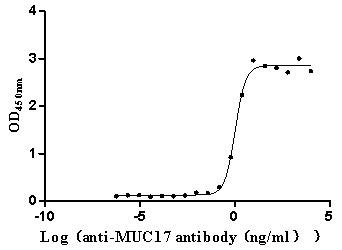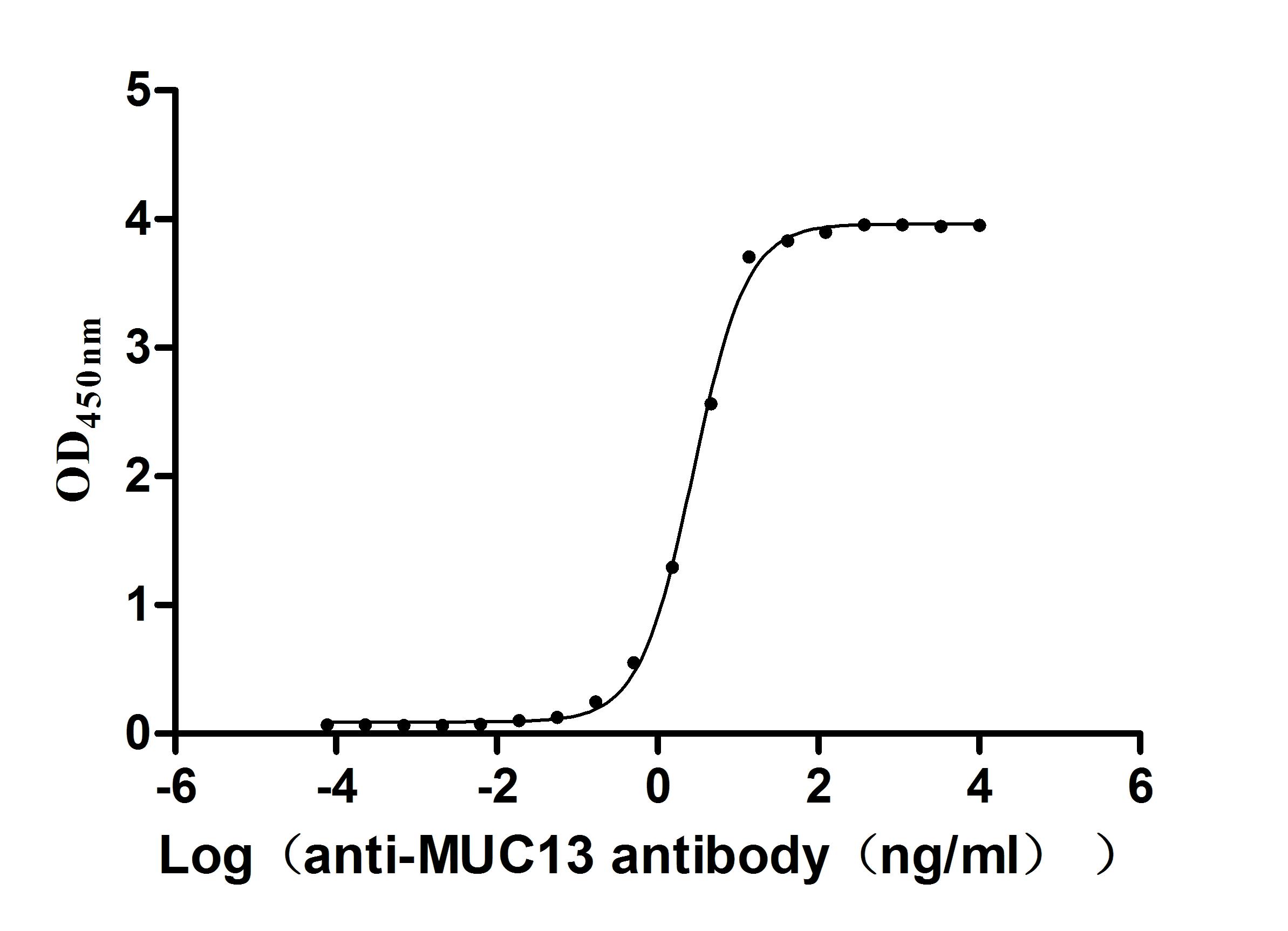Recombinant Mouse Mothers against decapentaplegic homolog 2 (Smad2)
-
货号:CSB-YP733826MO
-
规格:
-
来源:Yeast
-
其他:
-
货号:CSB-EP733826MO
-
规格:
-
来源:E.coli
-
其他:
-
货号:CSB-EP733826MO-B
-
规格:
-
来源:E.coli
-
共轭:Avi-tag Biotinylated
E. coli biotin ligase (BirA) is highly specific in covalently attaching biotin to the 15 amino acid AviTag peptide. This recombinant protein was biotinylated in vivo by AviTag-BirA technology, which method is BriA catalyzes amide linkage between the biotin and the specific lysine of the AviTag.
-
其他:
-
货号:CSB-BP733826MO
-
规格:
-
来源:Baculovirus
-
其他:
-
货号:CSB-MP733826MO
-
规格:
-
来源:Mammalian cell
-
其他:
产品详情
-
纯度:>85% (SDS-PAGE)
-
基因名:
-
Uniprot No.:
-
别名:Smad2; Madh2; Madr2; Mothers against decapentaplegic homolog 2; MAD homolog 2; Mothers against DPP homolog 2; Mad-related protein 2; mMad2; SMAD family member 2; SMAD 2; Smad2
-
种属:Mus musculus (Mouse)
-
蛋白长度:Full Length of Mature Protein
-
表达区域:2-467
-
氨基酸序列SSILPFTPP VVKRLLGWKK SAGGSGGAGG GEQNGQEEKW CEKAVKSLVK KLKKTGRLDE LEKAITTQNC NTKCVTIPST CSEIWGLSTA NTVDQWDTTG LYSFSEQTRS LDGRLQVSHR KGLPHVIYCR LWRWPDLHSH HELKAIENCE YAFNLKKDEV CVNPYHYQRV ETPVLPPVLV PRHTEILTEL PPLDDYTHSI PENTNFPAGI EPQSNYIPET PPPGYISEDG ETSDQQLNQS MDTGSPAELS PTTLSPVNHS LDLQPVTYSE PAFWCSIAYY ELNQRVGETF HASQPSLTVD GFTDPSNSER FCLGLLSNVN RNATVEMTRR HIGRGVRLYY IGGEVFAECL SDSAIFVQSP NCNQRYGWHP ATVCKIPPGC NLKIFNNQEF AALLAQSVNQ GFEAVYQLTR MCTIRMSFVK GWGAEYRRQT VTSTPCWIEL HLNGPLQWLD KVLTQMGSPS VRCSSMS
-
蛋白标签:Tag type will be determined during the manufacturing process.
The tag type will be determined during production process. If you have specified tag type, please tell us and we will develop the specified tag preferentially. -
产品提供形式:Lyophilized powder
Note: We will preferentially ship the format that we have in stock, however, if you have any special requirement for the format, please remark your requirement when placing the order, we will prepare according to your demand. -
复溶:We recommend that this vial be briefly centrifuged prior to opening to bring the contents to the bottom. Please reconstitute protein in deionized sterile water to a concentration of 0.1-1.0 mg/mL.We recommend to add 5-50% of glycerol (final concentration) and aliquot for long-term storage at -20℃/-80℃. Our default final concentration of glycerol is 50%. Customers could use it as reference.
-
储存条件:Store at -20°C/-80°C upon receipt, aliquoting is necessary for mutiple use. Avoid repeated freeze-thaw cycles.
-
保质期:The shelf life is related to many factors, storage state, buffer ingredients, storage temperature and the stability of the protein itself.
Generally, the shelf life of liquid form is 6 months at -20°C/-80°C. The shelf life of lyophilized form is 12 months at -20°C/-80°C. -
货期:Delivery time may differ from different purchasing way or location, please kindly consult your local distributors for specific delivery time.Note: All of our proteins are default shipped with normal blue ice packs, if you request to ship with dry ice, please communicate with us in advance and extra fees will be charged.
-
注意事项:Repeated freezing and thawing is not recommended. Store working aliquots at 4°C for up to one week.
-
Datasheet :Please contact us to get it.
靶点详情
-
功能:Receptor-regulated SMAD (R-SMAD) that is an intracellular signal transducer and transcriptional modulator activated by TGF-beta (transforming growth factor) and activin type 1 receptor kinases. Binds the TRE element in the promoter region of many genes that are regulated by TGF-beta and, on formation of the SMAD2/SMAD4 complex, activates transcription. May act as a tumor suppressor in colorectal carcinoma. Positively regulates PDPK1 kinase activity by stimulating its dissociation from the 14-3-3 protein YWHAQ which acts as a negative regulator.
-
基因功能参考文献:
- The expression of Toll-like receptor (TLR)4 and NF-kappaB p50 was also inhibited by Andro. Additionally, in vitro data confirmed that Andro treatment not only attenuated the expression of profibrotic and proinflammatory factors but also blocked the TGF-beta1/Smad2 and TLR4/NF-kappaB p50 pathways. PMID: 29743985
- both ERK and Smad2 signal pathways are involved in the activation of macrophages induced by TGF-b1 and high-ambient glucose, while there is no crosstalk shown in the process. PMID: 29199516
- Kidney samples from patients with advanced stages of diabetic nephropathy showed elevated pSmad2 staining whereas db/db mouse kidneys surprisingly showed a decrease in pSmad2 in the tubular compartment. These results indicate a lack of translation from type 2 diabetes patient kidneys to the db/db model with regards to Smad signaling pathway. PMID: 28805484
- Results suggest that Smad2/3 linker threonine phosphorylation is expressed during acinar-ductal metaplasia. PMID: 28099259
- NODAL/Activin signaling induces dramatic chromatin landscape changes, and a dynamic transcriptional network regulated by SMAD2, acting via multiple mechanisms. PMID: 28191871
- Blocking Smad2/3 signaling in pluripotent stem cells results in epigenetic changes that enhance the capacity for endoderm differentiation. PMID: 27012147
- cells expressing mutant huntingtin have a dysregulated transcriptional response to epidermal growth factor stimulation PMID: 27988204
- Smad2- and Smad3-deficient bone marrow (BM) cells display reduced sensitivity to transforming growth factor-beta (TGFbeta) inhibition. PMID: 28666967
- Data (including data from studies using knockout mice) suggest Garp/Lrrc32 is involved in up-regulation of Tgfb3 and is essential for embryogenesis of palate; Garp knockout causes postnatal lethality, cleft palate, and decreased apoptosis and Smad2 phosphorylation in medial edge epithelial cells of palatal shelf of embryos. (Garp = glycoprotein A repetitions predominant protein; Tgfb3 = transforming growth factor beta 3) PMID: 28912269
- Lnc-LFAR1 binds directly to Smad2/3 and promotes transcription of TGFbeta, Smad2, Smad3, Notch2 and Notch3 which, in turn, results in TGFbeta and Notch pathway activation. PMID: 28747678
- P311 is a novel TGFbeta1/Smad signaling-mediated regulator of transdifferentiation in epidermal stem cells during cutaneous wound healing. PMID: 27906099
- the levels of Smad2/3, P-Smad2/3 expressions were decreased, while the level of Smad7 expression was increased after treatment with osthole. PMID: 27870967
- These findings implicate TGF-beta-Smad2/3 signaling in activated tissue-resident cardiac fibroblasts as principal mediators of the fibrotic response. PMID: 28891814
- In order to study the translation between mouse model and patients, we evaluated the signature of phosphorylated Sma- and Mad-related protein 2 (pSmad2), as molecular marker of TGF-beta/activin activity, in the kidneys of streptozotocin (STZ)-treated mice compared to that of type 1 diabetes (T1D) patients. PMID: 28064277
- selective inhibition of SMAD3 or CCT6A efficiently suppresses TGF-beta-mediated metastasis. Findings provide a mechanism that directs TGF-beta signaling toward its prometastatic arm and may contribute to the development of therapeutic strategies targeting TGF-beta for non-small-cell lung carcinoma. PMID: 28375158
- These results suggest that Nedd9 is a Smad2/3 target gene implicated in RANKL-induced osteoclastogenesis. PMID: 27336669
- In conclusion, TGF-beta signaling pathway may influence liver fibrosis by incorporating with YB-1, indicating that YB-1 could be a potential target for therapies against liver fibrosis. PMID: 28153731
- miR-27b is an anti-fibrotic microRNA that inhibits fibroblast activation by targeting TGFbeta receptor 1 and SMAD2. PMID: 28095798
- hese studies revealed that Smad2 plays an essential role in the development of the growth plate, that both Smads 2 and 3 inhibit Ihh expression in the neonatal growth plate, and suggested they accomplish this by binding to distinct SBEs, mediating assembly of distinct repressive complexes. PMID: 27741240
- This study found evidence of increased leukocyte phosphorylated-Smad2/3 staining in both single leukocytes and platelet-leukocyte aggregates in mice that developed aortic valve stenosis, suggesting the presence of increased circulating active TGF-beta1. PMID: 27067480
- upregulated in the precision-cut kidney slice model of renal fibrosis PMID: 26919280
- Data show that muscle-specific Smad proteins Smad2/3-deficient mice exhibited significant resistance to denervation-induced muscle atrophy. PMID: 27129272
- these data demonstrate that the SMI drives ES cells to skeletal muscle via concerted activation of the Wnt pathway, and inhibition of Smad2/3 signaling and Shh pathways. PMID: 26577380
- Arsenite disrupts zinc-dependent TGFbeta2-SMAD2/3 activity during murine cardiac progenitor cell differentiation. PMID: 26354774
- Smad2 and Smad3 oppositely modify STAT3-induced transcription of IL-17A and retinoic acid receptor-related orphan nuclear receptor, RORgammat encoded by Rorc, by acting as a co-activator and co-repressor of STAT3, respectively. PMID: 26194464
- Endoplasmic reticulum stress in hepatic stellar cells promotes liver fibrosis by inducing over expression of SMAD2. PMID: 26435271
- pSmad3L-Ser signalling correlates with carcinogenesis of colon tumors and this work supports the hypothesis that pSmad2/3L-Thr immunostaining-positive cells are cancer stem cells. PMID: 25908723
- These results suggest that TGF-beta regulates RANKL-induced osteoclastogenesis through reciprocal cooperation between Smad2/3 and c-Fos. PMID: 25431176
- Treatment with geniposide almost completely blocked the phosphorylation of Smad2/3, extracellular signal-regulated kinase (ERK) and Akt in AML12 cells. PMID: 25818617
- Deficiency of MKP5 resulted in increased inflammatory activation in macrophages. These findings thus demonstrate that MKP5 critically controls inflammation in white adipose tissue and the development of metabolic disorders PMID: 25931117
- Data show that the Notch pathway is involved in kidney fibrosis through activation of transforming growth factor beta (TGF-beta)/Smad proteins 2/3 (Smad2/3) signaling. PMID: 25150830
- Studies indicate that Nodal/Smad2-dependent signals govern initial proximal-distal polarity and formation of the anterior visceral endoderm (AVE). PMID: 24704361
- In conclusion, this study identifies opposing roles for Smad2 and Smad3 in peritoneal dialysis-associated peritoneal fibrosis PMID: 24925688
- Suggest pSmad2/3 could serve as biomarkers for small intestine and colon stem cells. PMID: 25185661
- Conditional deletion of Smad2, but not Smad3, from XY primordial germ cells led to a loss of male-specific gene expression. PMID: 25605784
- Suppression of apoptosis through targeting of Smad2 by the polyomavirus miRNA is expected to synergize with anti-apoptotic effects previously attributed to the polyoma tumor antigens in support of virus replication in the natural host. PMID: 25146733
- The unfolded protein response is requisite for the specification of endoderm cell fate in early embryonic development via the synthesis and translocation of beta-catenin from the cytoplasm to nuclei and transient activation of Smad2. PMID: 25092289
- pulmonary TGF-beta1/Smad2 signaling in mice is associated with acute pancreatitis-associated acute lung injury PMID: 24688224
- TGF-beta signalling is sufficient and required via SMAD2/3 to drive mouse mesodermal stem cells towards the tendon lineage. PMID: 25249460
- Smad2 overexpression inhibits the proliferation of JE cells by down-regulating c-Myc and up-regulating P15 and P27, which resulted in an increase in pRB, leading to cell-cycle arrest. PMID: 25023446
- FGF2 regulates lymphatic endothelial cell -specific gene expression and suppresses TGFB1 signalling through Smad2. PMID: 24357720
- TGF-beta-induced phosphorylation of Smad2/3 in reactive gliosis is reduced by inhibition of KCa3.1 channels. PMID: 24606313
- Smad2 is an important factor in regulating progenitor-specific vascular smooth muscle cell development from neural crest cells. PMID: 23817199
- Smad2-dependent inhibition of miR-30s in podocytes. PMID: 24086574
- myostatin and TGFbeta1 stimulate C2C12 proliferation primarily via Smad2 PMID: 24424069
- we provided genetic evidence that Smad2 and Smad4 are required for Th9 differentiation. PMID: 24108699
- a nuclear envelope-localized mechanism of inactivating TGF-beta signaling in which MAN1 competes with transcription factors for binding to Smad2 and Smad3 and facilitates their dephosphorylation by PPM1A. PMID: 23779087
- Conditional inactivation of p53 in mouse ovarian surface epithelium does not alter MIS driven Smad2-dominant negative epithelium-lined inclusion cysts or teratomas. PMID: 23741457
- faulty versican clearance due to ADAMTS5 deficiency blocks the initiation of pSmad2 signaling, which is required for excavation of endocardial cushions during aortic and pulmonary valve development. PMID: 23531444
- the microtubule cytoskeleton plays an important role in mediating TGF-beta/SMAD2 signals to control E-cadherin gene expression in medial edge epithelium during palatal fusion. PMID: 23585353
显示更多
收起更多
-
亚细胞定位:Cytoplasm. Nucleus.
-
蛋白家族:Dwarfin/SMAD family
-
数据库链接:
KEGG: mmu:17126
STRING: 10090.ENSMUSP00000025453
UniGene: Mm.152699
Most popular with customers
-
Recombinant Human Claudin-6 (CLDN6)-VLPs (Active)
Express system: Mammalian cell
Species: Homo sapiens (Human)
-
Recombinant Human Mucin-17 (MUC17), partial (Active)
Express system: Mammalian cell
Species: Homo sapiens (Human)
-
Recombinant Human Desmoglein-3 (DSG3), partial (Active)
Express system: Baculovirus
Species: Homo sapiens (Human)
-
Recombinant Human Cadherin-17 (CDH17), partial (Active)
Express system: Mammalian cell
Species: Homo sapiens (Human)
-
Recombinant Human CD70 antigen (CD70), partial (Active)
Express system: Mammalian cell
Species: Homo sapiens (Human)
-
Recombinant Human Cadherin-1(CDH1),partial (Active)
Express system: Mammalian cell
Species: Homo sapiens (Human)
-
Express system: Mammalian cell
Species: Homo sapiens (Human)
-
Recombinant Human Mucin-13(MUC13),partial (Active)
Express system: yeast
Species: Homo sapiens (Human)


-AC1.jpg)

















